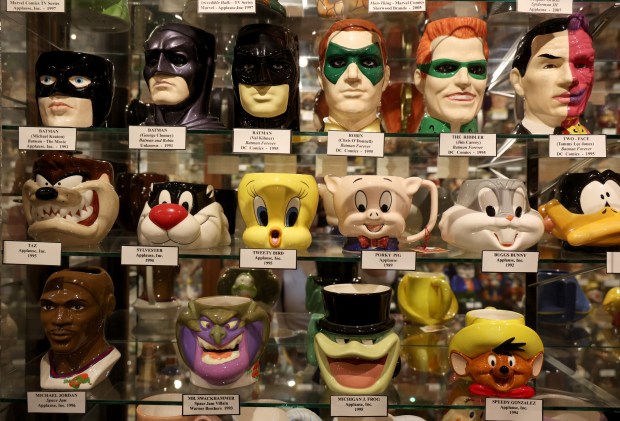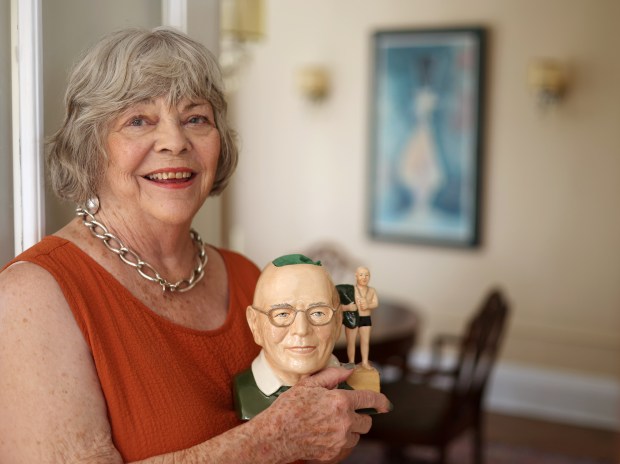Stephen Mullins collected Toby jugs.
That’s true, though kind of like saying Michael Jordan played basketball. Some people are the greatest at one thing. Mullins was a champion swimmer, and for most of his life on Chicago’s North Shore, he was a successful Evanston real estate developer. But he was exceedingly good at acquiring Toby jugs. He was so skilled at this that his collection outpaced the size of his sizable home, then his office, so Mullins reworked a former bank into a six-story building on Chicago Avenue in Evanston to keep his collection. It’s still there, at the corner of Chicago and Main; there’s condos in it now and a Subway franchise, so it’s not just storage space for Toby jugs. But really, says his widow, Carol Mullins, her husband wanted it as a dedicated space (with custom shelving) for Toby jugs.
Indeed, at Carol’s home, in the living room, there is one prominent jug on a shelf. It has the likeness of her late husband, wearing a sweater the exact green of his beloved Dartmouth College. Inside the head, where you sip your drink, Mullins’ ashes are kept.
What, you are asking yourself by now, is a Toby jug?
A Toby jug is one of those old-timey ceramic mugs shaped to look like a person — traditionally, a caricature of a British drunkard, ruddy complexion, tricorn hat, long coat, on a stool, cradling a mug of lager. Across the 250 year or so history of the Toby jug, there have been jugs with the likenesses of Winston Churchill and Barack Obama, Shakespeare and Charles Dickens, Gandhi, Hitler and Spuds MacKenzie. A Toby, to be specific, shows a full figure likeness, and a “character mug” shows only the bust of a figure. But Mullins bought both, and anything else (pitchers, thimbles) remotely related.
So, about 19 years ago, in the building he made for his collection, he established the American Toby Jug Museum as a nonprofit foundation, with free admission for all. It’s still open, just five hours a week, at the very inconvenient time of Tuesday afternoons. The elaborateness of this gesture is so oddball to so many passersby that the museum became a routine mention in any roundup of Weird Midwestern stops. “To be frank, the place has become a roadside attraction of sorts,” said his daughter Beth Mullins Scales.
Before Mullins died in 2019 of complications from colorectal cancer, he established a trust to keep the American Toby Jug Museum operating five years after he was gone. It still gets about 3,000 visitors a year, and there seems to be enough money to keep it going longer. But come March, those five years will be up and the museum will close.
Asked why, Carol, 87, leans back in a chair on her patio.
“Toby jugs were Steve’s thing, never my thing.”
Yet she now owns mountain of Toby jugs — the largest collection in the world, many thousand of them — along with a museum dedicated to an obscure art. “I think I’m owner of the museum,” she laughs. “Attorneys think I am.” She looks around her porch, which, until the museum opened in 2005, had been cluttered with jugs. She hates clutter. She asked her husband to get them out of the house. A museum was his answer. “The thing is, it costs more now than it’s worth to keep open.” Kevin Pearson, a ceramic jug maker and dealer, her husband’s close friend, served as the museum’s executive director and chief curator for years. But now he wants to retire from the museum. “I told Steve maybe the Art Institute would take them,” Carol says. “He said they’d just put them in a basement and no one would ever see them again. He wanted them to be seen most of all. Collectors, you know, are a dying breed.”
On a recent Tuesday, Beth Mullins Scales was photographing a Toby jug. Her head and camera were poked inside a small makeshift studio she built in a hallway of the museum. As a handful of visitors wandered glass case to glass case, admiring, noting the vastness of the collection — “Boy, huh, I mean, wow, got a lot of ‘em, don’t they? — Scales turned a Toby of an obscure British politician and snapped a picture, turned it again, snapped another picture, turned it a third time, snapped a picture, then moved on to a new Toby.
“I have been doing this for years,” she laughed morosely.
After her father died, Scales — and her father’s network of friends and fellow Toby collectors — decided there needed to be a digital archive of every jug in the place. There are about 8,500 Tobys in the place, behind glass, row after row after row, a maze of Toby jugs inside cases outfitted with backing mirrors (because, of course, some Tobys have two faces and her father needed visitors to see all sides of his jugs. Beth can see the end of this archiving project in sight; she’s down to a handful of glass cases now.
“It’s interesting to me about the drive some people have to collect so much,” she said. “I’m not collector, but I get it. If you’re going to collect, it’s better to have them all. That’s what my dad was like. Now my mom, who is reasonable about this, she feels responsible for it. She’s 87! Sharp as a tack. But the mission of the place was to share and educate, and it’s done that as well as anything could. Mom said” — she lowered her voice to a whisper — “‘I don’t want my kids to deal with this (expletive) after I’m dead.’”
So, there’s a plan to get rid of 8,500 Toby jugs.
Rather than flood the collector market, Pearson — who also owns Kevin Francis Ceramics and Face Pots — has helped connect the museum’s holdings with specific collectors; Gene Kelly’s widow recently called to purchase a jug with the likeness of the star. Some have sold for as much as $25,000, though many go for far less. (The museum offers a table of also-ran jugs at $10 a pop.) What doesn’t sell before the museum closes in spring — which is most of it, Carol presumes — will go to a friend and antique dealer in Florida, who plans to sell the jugs at collector’s shows.
Truly, there is something for everyone.
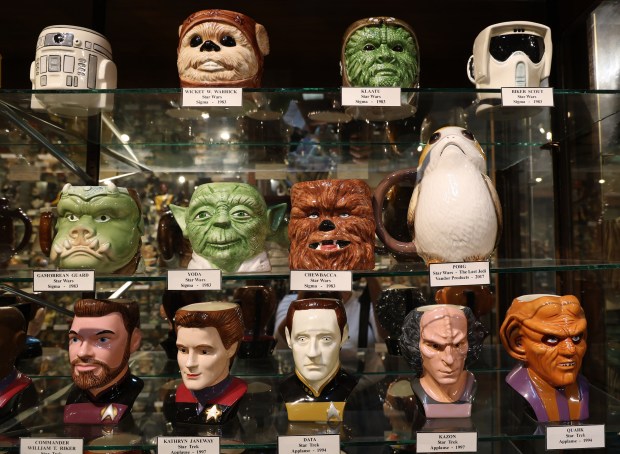
You know the last scene of “Raiders of the Lost Ark” in which the camera pulls back to show the Ark being stored inside a horizonless warehouse? Imagine a much smaller room, though no less dense. Once case contains Toby jugs of Mick Jagger, Pope John Paul II and John Wayne. Another holds jugs of lobsters, eagles, gargoyles and owl jugs made in 1912. There are bear jugs from the 19th century, and blue Napoleon jugs made within a few years of his death. There’s a Gene Simmons jug in which the rock star’s long tongue provides the handle. There are “Star Wars” jugs and “Star Trek” jugs and Bullwinkle jugs and Harry Potter jugs and Elvis jugs and Beatles jugs. There are jugs that aim for a realistic portrayal of a figure and jugs of Prince Charles that look like Dumbo. There’s so many different Churchills that a few are indistinguishable from W.C. Fields jugs. Because of the process it took to make certain jugs, some still look sweaty even decades later; others resemble totems, some look carved in sand.
There are jugs of Dickens characters — Little Dorrit, Fagin, Tiny Tim — and jugs of characters that celebrate a production of Gilbert & Sullivan’s “Mikado.” There’s a Bud Frog jug and a Mr. Peanut, and one jug made in 1980 by a British marmalade company that’s just shy of a racist caricature. Many of the Tobys say something about the times in which they were created. Many older jugs take on the crude appearance of early folk art, with holes in characters that allow liquids to stream out of every conceivable orifice.
One glass case holds American presidents — and the Three Stooges.
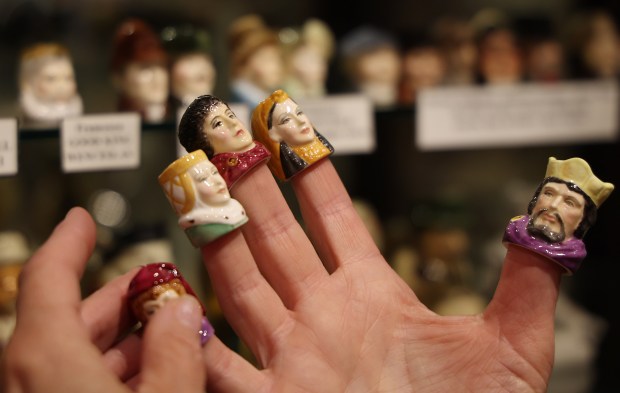
Mullins began collecting at 15, during summer camp in Canada in 1947. He mailed home six Toby jugs. Home was Kenilworth. Mullins was an only child and New Trier High School graduate who, while stationed later with the military in Europe, would send home chests full of Toby jugs. He caught a Toby bug and since his mother “would never say that she didn’t really like the jugs,” his wife says, he bought more and more. Mullins toured the world ever after, always keeping an eye on more Toby mugs, though largely he stuck to England, where the art form first flourished in the mid-18th century. These trips often brought him into living rooms of working-class British with their own Toby bugs. The origin of the name, “Toby,” is murky, though likely derived from either Sir Toby Belch, the drunken reveler of “Twelfth Night,” or Toby Fillpot, a fictional English boozer best known now for being the jovial, sloshed model depicted on a great many Toby jugs.
Arguably, it’s not the strangest Midwest museum dedicated to a very niche topic. Wisconsin has a mustard museum. Minnesota has a Spam museum. In the small Illinois village of Gridley, just east of Peoria, there is a little-known museum about telephones. But it may be the most exhaustive. For most of its 19 years, it had at least one curator.
Today, Katherine Ripley, a friend of Pearson, somewhat serves that role, helping “move the collection along,” as she puts it. She is learning Toby jugs on the job. She still finds the place overwhelming, and admirable. She points to a Dracula Toby that came from Teleflora. “(Stephen Mullins) was no elitist about this.” Like Carol Mullins, she also finds it a little kitschy, and a creepy, a museum of static, staring faces with fixed expressions. Because some of the makers of these Tobys considered the art form a vehicle for teaching history, there are not only United States presidents and British prime ministers but Third Reich members — Goring, Himmler. Recently she sold one of their several Hitler jugs.
The museum has good days and bad.
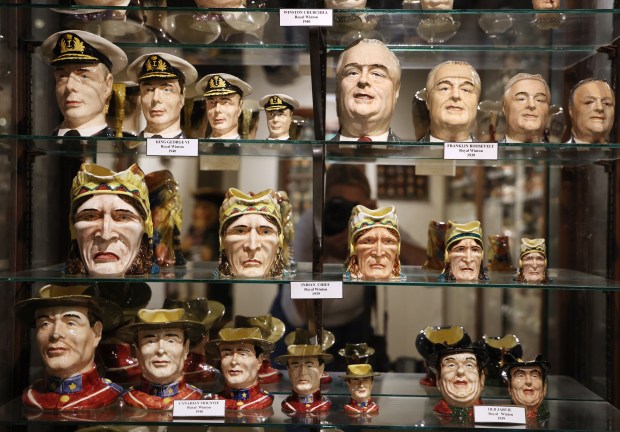
A good day is two dozen visitors, a bad is four. The Mullins family, said Scales, wanted to always treat the museum sincerely, with reverence, and also the slightest eye roll. Her father had a bit of “Absentminded Professor quality, the kind of focus where he couldn’t hear you talking to him.” She reached for a Toby jug of her father and studied it.
She held it before her, like Hamlet with the skull, pondering what was once in that head.
“Even if you casually knew him, you knew three things: went to Dartmouth, was a big swimmer, and collected Toby jugs.” She crinkled her eyes. “This jug makes him look old. Also pink. Dad was always tanned, he rode around in a convertible. He was a person of passions, and he never stopped.” With that, she put Stephen Mullins back on the shelf.
cborrelli@chicagotribune.com
